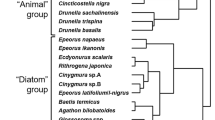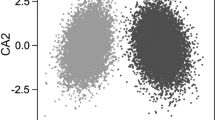Abstract
We examined near-shore habitat use by larval shortnose and Lost River suckers in the lower Williamson River and Upper Klamath Lake of south-central Oregon. Emergent macrophytes Scirpus, Sparganium and Polygonum supported significantly more, larger, and better-fed larvae than submergent macrophytes, woody vegetation, or open water. Abundance, size, and gut fullness were similar for sucker larvae collected from different emergent macropytes. During the larval period, there was no evidence of density dependant effects or habitat shifts. Ranked catch per unit effort data indicated potential predators also were more likely to use emergent macrophytes, but ordination indicated larvae and potential predators were differentially distributed along a vegetation structure-water depth gradient with larvae in shallow vegetated areas. Between-habitat differences appeared to be due to larval sucker selection for, or better survival in, emergent macrophytes, rather than differential access or exclusion from other habitats. The importance of emergent macrophytes appears to be related to increased foraging success and reduced predation. Because larvae in emergent macrophytes have a size and gut fullness advantage, the amount of emergent habitat could affect early survival. However, interannual differences in recruitment to the adult population may or may not be dependent on larval dynamics. Our results suggest larval sucker access to emergent macrophytes may be necessary, but perhaps not sufficient, for promoting good year class formation.
Similar content being viewed by others
References
Cooperman, M. S. & D. F. Markle. 2003. Relationships between river and. floodplain use, and rapid outmigration of adfluvial Lost River and shortnose sucker larvae. Trans. Am. Fish. Soc. 132: 1138-1153.
Cowan, J. H. Jr. & R. F. Shaw. 2002. Recruitment. pp. 88-111. In: L. A. Fuiman & R. G. Werner (eds. ), Fishery Science: The Unique Contributions of Early Life Stages, Blackwell Pub-lishing Co., Osney Mead, Oxford, United Kingdom.
Diana, J. S. 1995. Biology and Ecology of Fishes, Cooper Publishing. Carmel, Indiana.
Dibble, E. D., K. J. Killgore & S. L. Harrel. 1996. Assessment of sh-plant interactions. Am. Fish. Soc. Symp. 16: 357-372.
Dunsmoor, L. 2000. Quantity, composition, and distribution of emergent vegetation along the lower river and Upper Klamath lake shorelines of the Williamson River delta, Oregon, Klamath Tribes Natural Resource Department, Chiloquin, Oregon. 27 pp.
Fretwell, S. D. & H. L. Lucas. 1970. On territorial behavior and other factors in. uencing habitat distribution in birds. I. Theoretical development. Acta Biotheor. 19: 16-36.
Graham-Mathews, W. V. & K. Barnard, with assistance from McBain and Trush, Inc. 1996. Conceptual riverine and riparian restoration plan for the lower Williamson River restoration project, Prepared for the Nature Conservancy. 34 pp.
Heck, K. L. & L. B. Crowder. 1991. Habitat structure and predator-prey interactions in vegetated aquatic systems. pp. 281-299. In: S. S. Bell, E. D. McCoy & H. R. Mushinsky (eds. ), Habitat Structure: The Physical Arrangement of Objects in Space, Chapman & Hall.
Houde, E. D. 1987. Fish early life dynamics and recruitment variability. Am. Fish. Soc. Symp. 2: 17-29.
Houde, E. D. 1994. Differences between marine and freshwater sh larvae: implications for recruitment. ICES J. Mar. Sci. 51: 91-97.
Jackson, D. A., P. R. Peres-Neto & J. D. Olden. 2001. What controls who is where in freshwater sh communities-the roles of biotic, abiotic, and spatial factors. Can. J. Fish. Aquat. Sci. 58: 157-170.
Kann, J. 1997. Ecology and water quality dynamics of a shal-low hypereutrophic lake dominated by cyanobacteria, Doc-toral dissertation, Department of Ecology, University of North Carolina at Chapel Hill. 110 pp.
Larson, E. W., D. L. Johnson & W. E. J. Lynch. 1986. A buoyant pop net for accurately sampling sh at artificial habitat structures. Trans. Am. Fish. Soc. 115: 351-355.
Markle, D. F. & M. S. Cooperman. 2003. Relationship between Lost River and shortnose sucker biology and management of Upper Klamath Lake. pp. 93-118. In: The 2001 water allo-cation decisions in the Klamath Basin. Extension Publica-tions, Oregon State University, Extension Services, Corvallis, Oregon.
Martin, B. A. & M. K. Saiki. 1999. Effects of ambient water quality on the endangered Lost River sucker in Upper Klamath Lake, Oregon. Trans. Am. Fish. Soc. 128: 953-961.
Miller, T. J., L. B. Crowder, J. A. Rice & E. A. Marschall. 1988. Larval size and recruitment mechanisms in shes: toward a conceptual framework. Can. J. Fish. Aquat. Sci. 45: 1657-1670.
Perkins, D. L., G. G. Scoppettone & M. Buettner. 2000. Reproductive biology and demographics of endangered Lost River and shortnose suckers in Upper Klamath Lake, Ore-gon. U. S. Geological Survey-Biological Resource Division, Reno, NV. Submitted to U. S. Bureau of Reclamation, Klamath Falls office. Klamath Falls, Oregon. Contract #4-AA-29-12160.
Philip Williams & Associates. 2001. Evaluation of proposed lake management on hydromechanics, water quality and eutrophication in Upper Klamath Lake. Prepared by Philip Williams and Associates, Ltd., Portland, Oregon, with Danish Hydraulic Institute-Institute of Water Environ-ment. Prepared for U. S. Bureau of Reclamation, Klamath Falls o. ce, Klamath Falls, Oregon. PWA reference #1412. 124 pp.
Rozas, L. P. & W. E. Odum. 1988. Occupation of submerged aquatic vegetation by shes: testing the role of food and refuge. Oecologia 77: 101-106.
Saiki, M. K., D. P. Monda & B. L. Bellerud. 1999. Lethal lev-els of selected water quality variables to larval and juvenile Lost River and shortnose suckers. Environ. Pollut. 105: 37-44.
Schindler, D. E. 1999. Migration strategies of young shes un-der temporal constraints: the effect of size-dependent over-winter mortality. Can. J. Fish. Aquat. Sci. 56(Supplement 1): 61-70.
Sinclair, M. 1988. The member/vagrant hypothesis. pp. 67-77. In: M. Sinclair (ed. ), Marine Populations: An essay on Pop-ulation Regulation and Speciation, Washington Sea grant Program, University of Washington Press, Seattle, Wash-ington.
Sogard, S. M. 1994. Use of suboptimal foraging habitats by shes: consequences to growth and survival. pp. 103-131. In: D. J. Stouder, K. L. Fresh & R. J. Feller (eds. ), Theory and Application in Fish Feeding Ecology, University of South Carolina Press.
Weaver, M. J., J. J. Magnuson & M. K. Clayton. 1997. Distri-bution of littoral shes in structurally complex macrophytes. Can. J. Fish. Aquat. Sci. 54: 2277-2289.
Werner, E. E. & J. F. Gilliam. 1984. The ontogenetic niche and species interactions in size-structured populations. Ann. Rev. Ecol. Syst. 15: 393-425.
Werner, E. E., J. F. Gilliam, D. J. Hall & G. G. Mittelbach. 1983. An experimental test of the effects of predation risk on habitat use in fish. Ecology 64: 1540-1548.
Werner, R. G. 2002. Habitat requirements. pp. 161-182. In: L. A. Fuiman & R. G. Werner (eds. ), Fishery Science: The Unique Contributions of Early Life Stages. Blackwell, Ox-ford, United Kingdom.
Author information
Authors and Affiliations
Rights and permissions
About this article
Cite this article
Cooperman, M.S., Markle, D.F. Abundance, size, and feeding success of larval shortnose suckers and Lost River suckers from different habitats of the littoral zone of Upper Klamath Lake. Environmental Biology of Fishes 71, 365–377 (2004). https://doi.org/10.1007/s10641-004-4181-x
Issue Date:
DOI: https://doi.org/10.1007/s10641-004-4181-x




